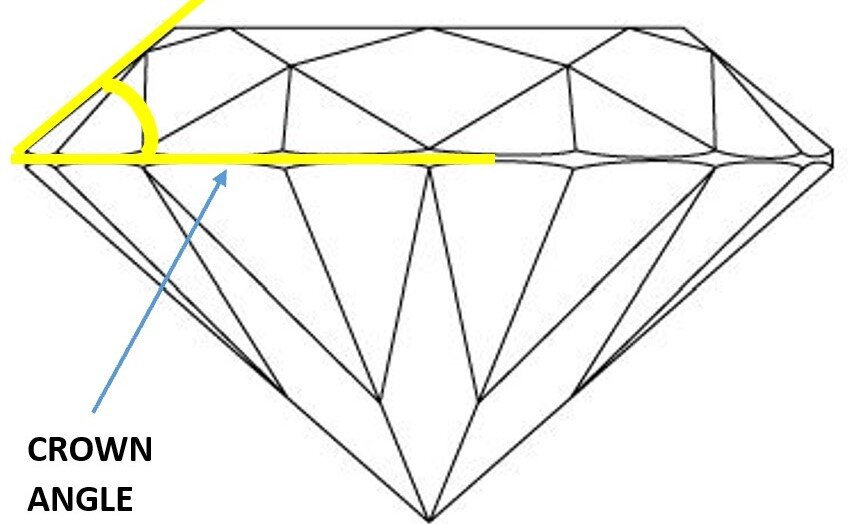Diamond Anatomy
Hello friends, and welcome back to the #RequiemReport Blog!
Today’s lesson is going to be a crash course on Diamond Anatomy. If you’ve read some previous blog posts or watched a #RequiemReport video and wondered “What the heck is a girdle?” or “I have no idea what a culet is”- fear not! We are going to cover it all. This blog post will teach you all the lingo, and give you the tools you need to follow along in all future #RequiemReport posts! By the time you’re done reading this, you’re going to be talking like a pro gemologist.
First things first, lets start with the basics. Throughout this post I am going to be using a round brilliant cut diamond as the example, but these terms apply to all sorts of the diamond shapes and cuts. So let’s get started!
One of the diamond anatomy terms you’ll hear most often is the “girdle”. When looking at a diamond from the top down, the girdle is what gives it its shape. Think of it as the outside perimeter of the diamond- sometimes referred to as the “belt” of the stone.
The girdle wraps around the widest part of the diamond, and it is a very important part of diamond anatomy. This edge is what is used to set the diamond into whatever piece of jewelry it is going to live in, so it needs to be the proper thickness. If a girdle is too thin, it makes the diamond more susceptible to chipping and breaking during the stone setting process, and makes it more vulnerable during every day wear. On the flip side, if the girdle is extremely thick, it can create an undesirable “fisheye” affect, where a reflection of the girdle is visible on the inside of the diamond. No good! For these reasons, the girdle needs to fall within the ideal range of thickness to keep the diamond safe and sparkly. The girdle can be left rough (unpolished), but it is often polished or even faceted like the rest of the diamond. Check out the chart below for how girdle thickness on a round brilliant cut is graded!
Girdle Thickness on a Round Brilliant Cut. Diagram from diamondbuzz.blog
So now that you know what the girdle is… lets talk about the “crown”. The crown is everything on a diamond above that girdle we just talked about. The crown of a diamond plays a huge role in how a diamond disperses light… so this is an important one!
There are ideal proportions for how tall the crown should be, and we measure it by using something called the “crown angle”, which is the angle formed by the girdle and the crown facets. In a round brilliant cut diamond, this angle should be somewhere between 31.5-36 degrees to be considered ‘excellent’.
The crown also includes another very important part of diamond anatomy… the “table”. The table is the large flat facet that you see when looking at a diamond from the top down. It is extremely important because it is the largest facet on a diamond, and it’s the one that lets the most light in and out of the stone- for that reason, table size can have a huge impact on the appearance of a diamond! Table size is expressed as a percentage of the total diameter of the diamond; and in a round brilliant cut, it should ideally be around 52-62% of the total diameter of the particular stone.
Okay- “Girdle”…CHECK! “Crown”…CHECK! Next up, the “pavilion”. So while everything above the girdle is the crown, everything below the girdle is the pavilion. Of course, like all things with diamonds, there are ideal proportions for the pavilion as well, and we measure this by using (you guessed it!) the “pavilion angle”. The pavilion angle is the angle formed by the girdle and the pavilion facets, and in a round brilliant cut, an excellent pavilion angle falls between 40.6 and 41.8 degrees. A high pavilion angle can create darkness in the center of the stone, and a low pavilion angle can allow for too much ‘light leak’ leaving the diamond looking dull and flat. So this is an important one!
The pavilion also includes the final diamond anatomy term we are going to discuss today… the “culet”. In simple terms, the culet is the bottommost tip of the diamond. In most modern diamonds, the culet is ‘pointed’, meaning everything comes to a perfect point at the bottom of the stone. In these cases, the diamond would be described as having 'no culet’ or a ‘pointed culet’- which is considered ideal. Though most modern diamonds fall into this category; sometimes, the culet is actually an extra flat facet at the bottom of the diamond. If the culet is indeed a flat facet, it is graded on scale from “very small” to “extremely large”, and its size can have a big affect on the face up appearance of a stone.
Well, you did it! Now you know the most commonly used and important diamond anatomy terms. You’ve learned about diamonds’ “girdle”, “crown”, “crown angle”, “table”, “pavilion”, “pavilion angle”, and finally, the “culet”. From now on you’re going to know exactly what I’m talking about when I use these terms in future blog posts or #RequiemReport videos, so make sure you stay tuned to keep putting this knowledge to good use!
Thanks for reading!









